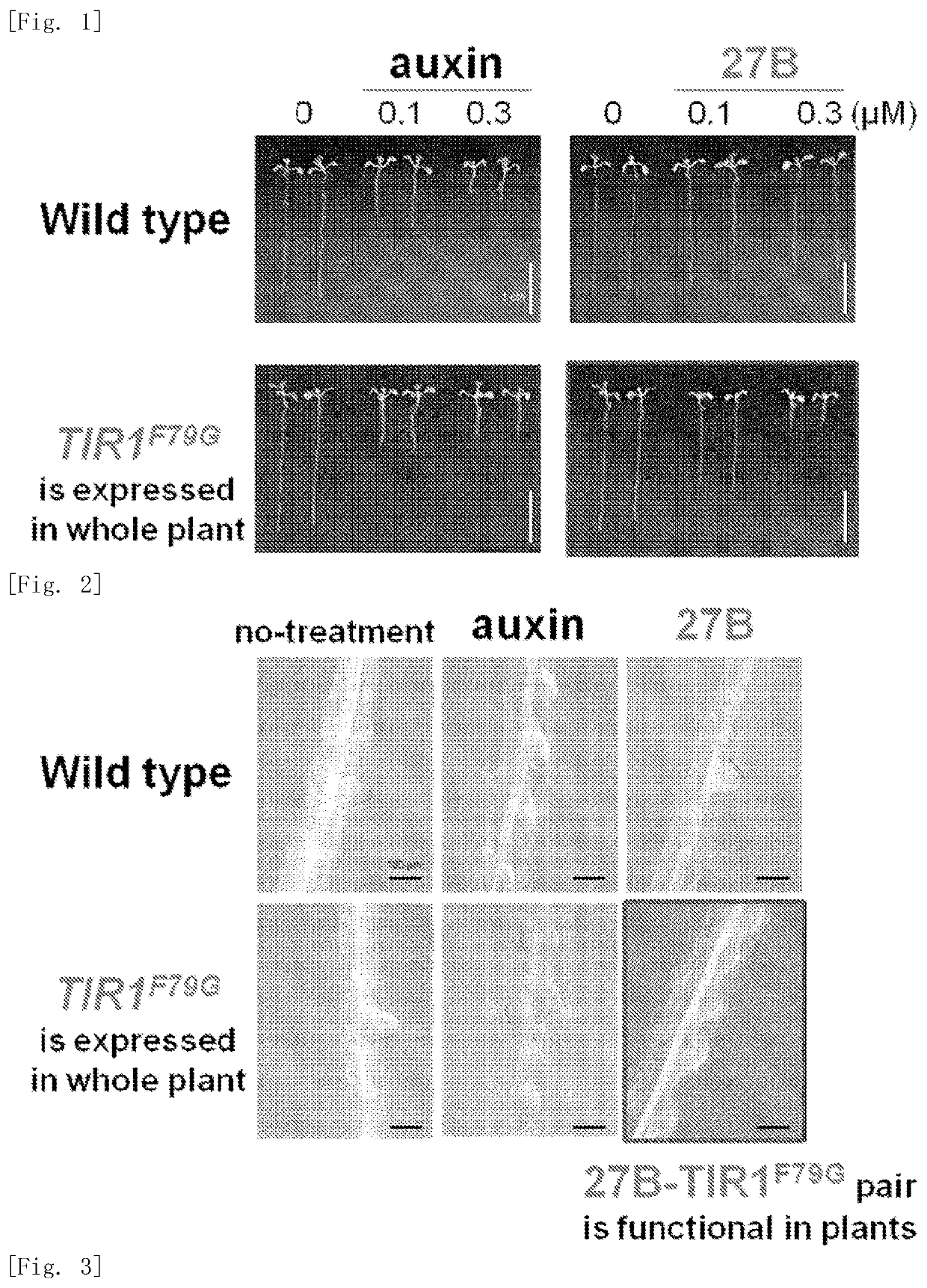Plant growth regulator
a technology of growth regulators and plants, applied in biocide, peptide sources, organic chemistry, etc., can solve problems such as plant death, and achieve the effects of reducing auxin-sensitivity, good binding affinity, and good binding affinity
- Summary
- Abstract
- Description
- Claims
- Application Information
AI Technical Summary
Benefits of technology
Problems solved by technology
Method used
Image
Examples
embodiment
[0151]Hereinafter, the present invention will be described in detail with reference to examples, but the present invention should not be construed as being limited thereto.
[0152]Unless otherwise specified, all reactants and reagents including dry solvents used were commercially available products. Unless otherwise restricted, all reactions were performed in air with reagent grade solvents. All work-up and purification procedures were performed in air with reagent grade solvents. Analytical thin layer chromatography (TLC) was performed using E. Merck silica gel 60 F254 pre-coated plates (0.25 nm). The developed chromatogram was analyzed with a UV lamp (254 nm). Flash column chromatography was performed using a Biotage Isolera® instrument equipped with a KANTO silica gel 60N (0.04-0.1 nm) or Biotage SNAP Ultra 10 g cartridge. Preparative thin layer chromatography (PTLC) was performed using a Wakogel® B5-F silica-coated plate (0.75 nm) prepared in advance. Reverse phase column chromato...
synthesis example 1
-3-yl)-2-oxoacetic acid
[0153]
[0154]5-Bromoindole (5.0 g, 25.5 mmol) was dissolved in diethyl ether (100 mL) and the resulting solution was cooled to 0° C. Oxalyl chloride (2.2 mL, 1.0 equiv.) was added dropwise to the flask, and the resulting reaction mixture was returned to room temperature. After the mixture was stirred at room temperature for 2.5 hours, the reaction was quenched with water (2.3 mL, 5.0 equiv.). The reaction mixture was filtered to give 2-(5-Bromo-1H-indol-3-yl)-2-oxoacetic acid as a yellow powder (6.8 g, quant.).
[0155]1H NMR (400 MHz, DMSO-d6) δ 12.48 (s, 1H), 8.48 (d, J=3.1 Hz, 1H), 8.29 (d, J=1.8 Hz, 1H), 7.52 (d, J=8.6 Hz, 1H), 7.43 (dd, J=8.9, 2.1 Hz, 1H).
synthesis example 2
-3-yl)acetic acid
[0156]
[0157]2-(5-Bromo-1H-Indol-3-yl)-2-oxoacetic acid (1.6 g, 7.0 mmol) was dissolved in 2-ethoxyethanol (31 mL), and hydrazine monohydrate (5 mL, 5 equiv.) was added to the flask. After the reaction mixture was stirred at 60° C. for 40 minutes, NaOMe (3.7 g, 10 equiv.) was added to the flask and stirred at 150° C. for an additional 7 hours. The reaction was quenched by the addition of water and the aqueous layer was washed 3 times with ethyl acetate. The aqueous layer was acidified with 6M aqueous hydrochloric acid, and the resulting precipitate was extracted with dichloromethane. The combined organic layers were dried over Na2SO4, filtered and concentrated under vacuum. The resulting residue was purified by reverse phase column chromatography (MeOH / MeCN) and reprecipitated (CHCl3 / hexane) to give 2-(5-Bromo-1H-indol-3-yl)acetic acid as a pale yellow powder (1.2 g, 72%).
[0158]1H NMR (400 MHz, CDCl3) δ 7.68 (d, J=1.8 Hz, 1H), 7.26 (d, J=8.6 Hz, 1H), 7.18 (dd, J=8.9,...
PUM
| Property | Measurement | Unit |
|---|---|---|
| Current | aaaaa | aaaaa |
| Sensitivity | aaaaa | aaaaa |
Abstract
Description
Claims
Application Information
 Login to View More
Login to View More - R&D
- Intellectual Property
- Life Sciences
- Materials
- Tech Scout
- Unparalleled Data Quality
- Higher Quality Content
- 60% Fewer Hallucinations
Browse by: Latest US Patents, China's latest patents, Technical Efficacy Thesaurus, Application Domain, Technology Topic, Popular Technical Reports.
© 2025 PatSnap. All rights reserved.Legal|Privacy policy|Modern Slavery Act Transparency Statement|Sitemap|About US| Contact US: help@patsnap.com



